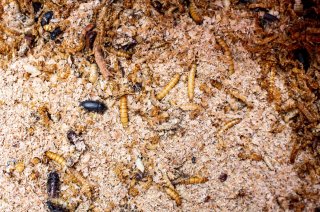
category_news
Insects as sustainable animal feed: real alternative?
Despite the growing number of vegetarian and vegan options, consumer demand for meat continues to rise. It is therefore important to also look at the sustainability of the meat sector: how can we ensure that livestock is kept in a more efficient way?
One possible solution is raising insects as animal feed. In an article published last week in Science, Arnold van Huis from Wageningen University & Research (WUR) and his colleague from Università degli Studi di Turino (I) list the main pros and cons.
Why insects as animal feed?
Livestock feed now consists of fishmeal and soy. Van Huis: “This kind of feed has adverse effects for the environment, in the case of soy, for example, deforestation and the use of pesticides. Depending on the animal to be fed, a portion of this fishmeal or soy can be replaced by insects. One big advantage of insects is that they can be fed using fruit and vegetable waste, and even manure. In this way, we can deploy these residual streams as high-quality feed for animals.”
In addition, raising insects leads to low greenhouse gases emissions, and requires little land and water. But there are more advantages, according to Van Huis: “Insects as livestock feed are not only a good source of nutrients, but also seem to be beneficial for the animals’ health. Chitin, the external skeleton of insects, turns out to strengthen the immune system. Insects as animal feed could even form a substitute for antibiotics.”
What is needed to apply this on a large scale?
Using insects as a new source of food for livestock therefore seems promising. But there are still some challenges, says the WUR researcher, such as automation of the production system, better digestion in the insects’ gut by using bacteria, genetic selection of insects so that larvae are better able to convert residues, disease prevention and the safe use of insects as an ingredient in animal feed.
Van Huis: “At the moment, the industry cannot produce enough insects to meet the demand for animal feed. Also, the price of insects as animal feed is still too high, although innovations will soon help bring prices down and make insects a competitive alternative for soy or fishmeal. The industry’s biggest challenge is to find sufficient, low-cost, reliable and safe organic waste streams that can be easily converted by insects into a high-quality feed product.”